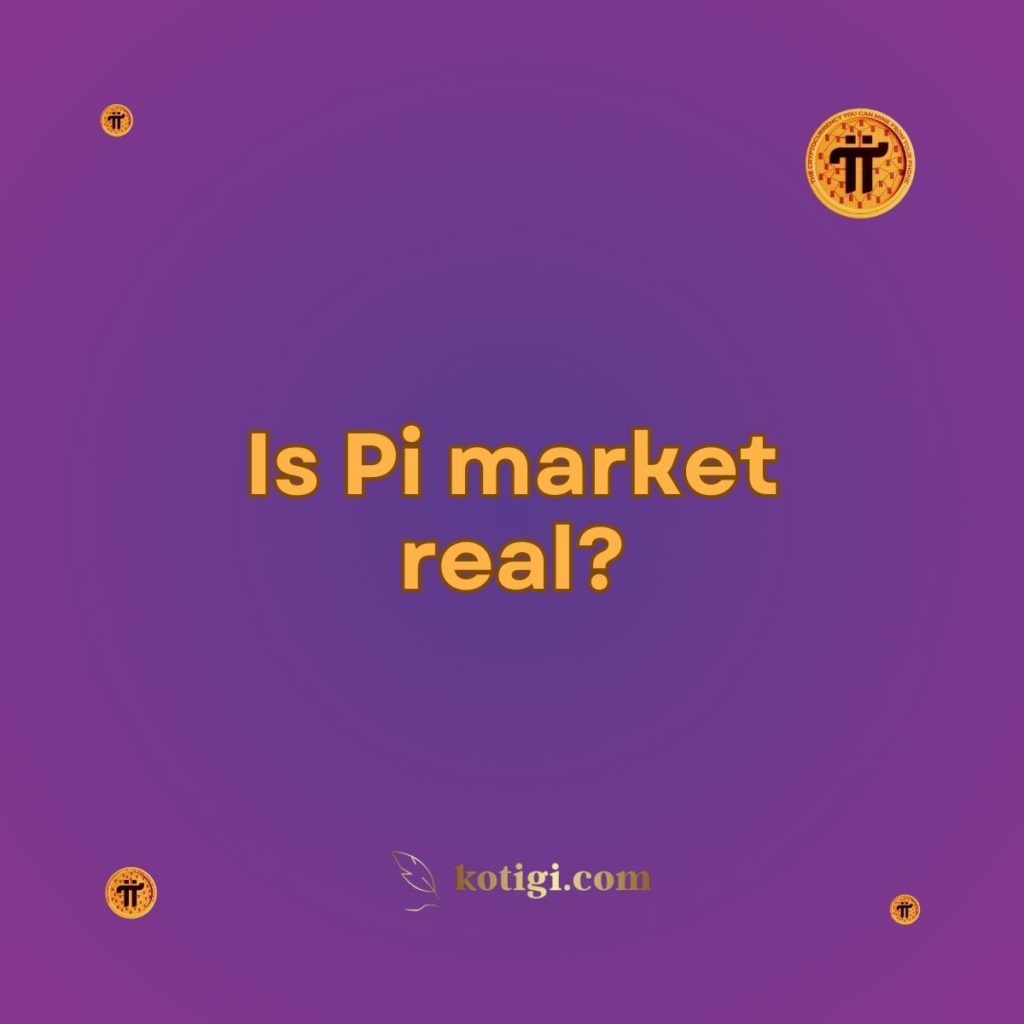
Is Pi market real?
The Pi Network has gained significant attention due to its unique approach to cryptocurrency mining via mobile devices, but questions remain about whether Pi’s market is real and if it holds any true value. While Pi is still in its enclosed mainnet phase and cannot be traded on public exchanges, there is speculation about its future viability as a legitimate cryptocurrency with a real market.
Introduction
As Pi Network continues to grow in popularity, the question arises: is the Pi market real? To answer this, it’s important to understand the current phase of Pi’s development, its future prospects, and what “real” means in terms of cryptocurrency markets. As of now, Pi does not have an established market value because it cannot be traded on public exchanges. However, Pi Network aims to eventually launch an open market where users can exchange Pi coins for other cryptocurrencies or fiat money.
This article delves into the current status of Pi’s market, whether it’s real or still speculative, and what the future may hold for this ambitious cryptocurrency project.
The Current Status of Pi Market
Pi in the Enclosed Mainnet Phase
Pi Network is still in its enclosed mainnet phase, meaning that Pi coins (or Pi tokens) are only tradable within the internal Pi Network ecosystem. Users can mine Pi using the mobile app, but these mined coins cannot be transferred out to external wallets or traded on popular cryptocurrency exchanges like Binance or Coinbase.
During this phase, the Pi market is not yet real in the traditional sense. There is no external liquidity or price discovery mechanism because users cannot trade Pi for fiat currency or other cryptocurrencies. The enclosed mainnet is intended to allow Pi Network to further develop and refine its platform before opening up to public trading.
What Is a Real Cryptocurrency Market?
A “real” market in the context of cryptocurrency involves several elements:
- Public Trading: The ability to trade the coin on external exchanges for other digital currencies or fiat money.
- Price Discovery: The process by which the value of the coin is determined based on market demand and supply.
- Liquidity: The ease with which the coin can be bought or sold on exchanges without causing significant price fluctuations.
Currently, Pi lacks all three elements, which is why some people argue that the Pi market is not yet real.
What Will Make Pi Market Real?
Transition to Open Mainnet
The most critical step in making the Pi market real is the transition from the enclosed mainnet to the open mainnet. The open mainnet will allow users to move Pi coins from the Pi Network ecosystem to external wallets and begin trading them on cryptocurrency exchanges. This transition would create a public market for Pi, giving it a market value determined by supply and demand dynamics.
When Pi is traded on exchanges, it will undergo price discovery, and users will be able to sell or buy Pi coins for fiat currencies or other cryptocurrencies, establishing a real, liquid market.
Exchange Listings
To have a real market, Pi coins must be listed on cryptocurrency exchanges. These listings provide the platform where traders can buy, sell, or exchange Pi coins. The exchanges help establish the liquidity of Pi and provide a mechanism for users to cash out their Pi coins if they choose to.
For now, there is no concrete information on which exchanges might list Pi, but successful cryptocurrency projects typically aim for listings on prominent platforms like Binance, Kraken, or Coinbase.
Factors Impacting Pi’s Market Value
Supply and Demand
Once Pi coins become tradable on exchanges, their market value will be influenced by supply and demand. The more people who are willing to buy Pi coins, the higher the price is likely to be. Conversely, if there is an oversupply of Pi coins with few buyers, the price could fall.
At launch, there may be an influx of users who have been mining Pi for years, which could temporarily increase the supply of Pi coins on the market. Whether demand will match or exceed that supply is still uncertain, as much depends on the future utility and adoption of Pi coins.
Pi’s Use Cases
Another key factor determining the real value of Pi coins is their utility. For Pi to have a sustainable market, it needs to be more than just a speculative asset. If Pi Network successfully develops a platform where Pi coins can be used for real-world transactions, payments, or services, it could drive demand and, consequently, market value.
If Pi remains purely speculative without clear use cases, its market value may fluctuate wildly and fail to establish long-term stability.
Regulatory Compliance
For Pi to operate in a real market, it must comply with various regulatory requirements in different jurisdictions. Cryptocurrencies are subject to rules around anti-money laundering (AML), know-your-customer (KYC) protocols, and securities regulations. If Pi Network can meet these standards, it will have a better chance of being listed on reputable exchanges and maintaining a legitimate market.
On the other hand, failure to comply with regulatory requirements could delay the project’s progress and limit the growth of Pi’s market.
Challenges in Establishing a Real Pi Market
Lack of Exchange Listings
One of the biggest challenges for Pi Network is securing listings on major cryptocurrency exchanges. Many exchanges have strict requirements, including regulatory compliance, liquidity provisions, and a strong user base. Pi Network will need to meet these standards to ensure its coins can be traded on public platforms.
The longer it takes for Pi to secure these listings, the more speculative the project may seem to both users and investors. This uncertainty can hinder the development of a real Pi market.
User Perception
Another challenge Pi faces is user perception. While Pi Network has attracted millions of users globally, some are skeptical of its real-world potential. Critics point to the lack of transparency about the project’s future, the absence of a confirmed timeline for the open mainnet, and the fact that Pi cannot currently be traded.
Convincing both users and investors that Pi is a legitimate and valuable cryptocurrency will be essential for creating a real market.
Potential for a Real Pi Market
The Role of Community
One of Pi Network’s greatest strengths is its large and growing community. With over 35 million active users mining Pi coins, Pi has a broad base of potential market participants once it becomes tradable. A large user base is essential for liquidity, as it ensures there are enough buyers and sellers to facilitate trades without significant price fluctuations.
If Pi Network can successfully leverage its community to drive adoption and usage, it could establish a strong market presence in the cryptocurrency space.
Adoption by Merchants and Platforms
Another potential path to a real market for Pi is through merchant adoption. If Pi coins are widely accepted by online retailers, service providers, and platforms, it would give the coin real utility, driving demand and market value. Pi Network has already launched initiatives to encourage the development of Pi-based marketplaces where users can spend their Pi coins.
Widespread merchant adoption could provide the practical use cases needed to establish Pi’s real value in the market.
What Users Can Expect Going Forward
Waiting for the Open Mainnet
For now, users will have to wait for Pi Network to transition to the open mainnet before a real market can form. This could take some time, as the development team is working on enhancing the platform’s scalability, security, and compliance. The launch of the open mainnet will be a crucial milestone for the project, as it will determine whether Pi coins can achieve real-world value.
Caution Against Scams
In the meantime, users should be cautious about any offers to trade or sell Pi coins on unofficial platforms. Since Pi cannot yet be traded externally, any claims of Pi market activity are likely fraudulent. Users should rely only on official Pi Network communications and wait for legitimate announcements about the open mainnet and exchange listings.
Long-Term Potential
If Pi Network successfully overcomes its challenges and secures exchange listings, the Pi market could become real, with true market value based on supply, demand, and use cases. However, this remains speculative until the project reaches its key milestones.
Conclusion
As of now, the Pi market is not real in the sense that Pi coins cannot be traded on public exchanges or converted into fiat currency. Pi Network is still in its enclosed mainnet phase, and users must wait for the launch of the open mainnet before Pi can be traded in a real market environment.
Key factors that will determine whether Pi has a real market in the future include the transition to the open mainnet, exchange listings, utility, and regulatory compliance. While Pi Network has great potential due to its large user base, it also faces challenges related to scalability, security, and public perception. For users, the best course of action is to remain patient, continue mining Pi, and stay informed about the project’s progress.
Key Takeaways:
- The Pi market is not real yet, as Pi coins cannot be traded on public exchanges.
- Pi Network is still in the enclosed mainnet phase, and users must wait for the open mainnet launch for a real market to develop.
- Exchange listings, use cases, and regulatory compliance are crucial for establishing Pi’s real market value.
- Users should avoid scams and remain patient while waiting for the open mainnet transition.
- Pi’s long-term market potential depends on successful execution of its development roadmap and community adoption.





